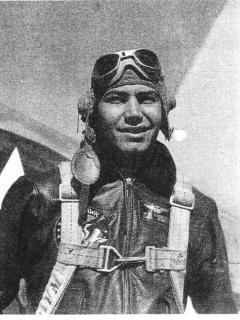VAUGHN-WARREN
WARREN EARL VAUGHN

2NDLT

KILLED AND CANNIBALIZED
WHILE A POW OF THE JAPANESE
Warren Earl Vaughn was born on September 20, 1922 in Childress, Texas, and raised in this Texas panhandle town by his single mother. Times were difficult for them as Mrs Vaughn made ends meet doing part-time work. As a boy, Warren earned spending money at the local ice plant and grocery store. He grew into a tall, very dark handsome young man with a dark complexion inherited from a distant Cherokee Indian relative on his mother’s side. Graduating from high school in 1941, Warren entered Southwest Texas State University, and to pay his way he took a part time job repairing airplane parts at the Naval Air Station, Corpus Christi, Texas.
In September 1943, Warren enlisted in the Marine Corps to become a Marine Aviator. Following receipt of his wings he learned to fly the Chance Vought F4U Corsair fighter, and following carrier qualification, was assigned as a replacement pilot to Marine Fighter Squadron 123. In February 1945 the squadron was transferred to the carrier USS Bennington and on February 23, Second Lieutenant Vaughn was the pilot of F4U-1D Corsair BuNo 82356 which departed Bennington with a flight of planes to attack Chichi Jima Island. It has his first and only combat flight. Chichi Jima Island is 620 miles south of Tokyo and part of the Bonin Island Group. During World War II the small island was critical to the Japanese communications services who used it as a strategic radio relay link. Missions here flew into the teeth of Chichi Jima’s lethal antiaircraft guns, somehow dodging the shells aimed at them, to release their bombs onto the reinforced concrete communications facilities on top of the island’s twin peaks. A gruesome incident on Chichi Jima that occurred late in the war was not revealed to the American public until 2003 and has become known as the Chichi Incident (or the Ogasawa Incident). In essence, Japanese soldiers reportedly tortured, killed and ate as many as eight American airmen being held as POWs – an act of cannibalism.
As 2NDLT Vaughn dove toward his target on February 23, 1945 he tried to ignore the glowing golf-ball-size projectiles that hurtled past his cockpit. Suddenly his Corsair shuddered violently as a strike tore away much of a wing and he instantly released his seat restraints, pushed open the canopy and bailed out at about 500 feet. An accompanying pilot later said, “Vaughn’s plane got hit. His wing was clipped off. When I flew over the target, I could see him going down in a chute. When he hit the water, he swam toward shore.” Reaching the water, 2NDLT Vaughn struggled to release the parachute and as he attempted to swim to the nearby shore, a Japanese soldier in a boat threw him a line. He was so exhausted he could barely stand, and his rescuer later said, “His lips were blue, his teeth chattered, and he shook too much to speak.” Taken ashore, 2NDLT Vaught was reportedly tied to a tree beside two other American airmen who had been shot down, unfed, and left alone for three days. 2NDLT Vaught was then turned over to a soldier who had been born in San Francisco and spoke perfect English. Despite their wartime differences, the two establish a friendly relationship. During the following days, the soldier tried to convince a superior officer that he was gaining valuable information, but the officer refused to believe it and announced that the prisoner was to be executed. Several days later, believed to be March 15, 1945, 2NDLT Vaughn was led to a bomb crater. Upon arrival he took on a look of defiance and when a guard tried to tie his hands, the guard was waved away. An officer approached Vaughn, announced he was to be beheaded, and reportedly said, “Are you prepared to meet death?” “Yes,” Vaughn replied. The officer then said, “Do you want to say anything?” and Vaughn was heard to say, “Go to hell!” “Then good-bye,” said the officer, and “Semper Fi!” Vaught shouted. After the execution, a superior Japanese officer ordered the body dissected, cooked and served the next day to high-ranking Japanese officers as part of their Spirit Warrior Indoctrination.
As none of 2NDLT Vaughn’s body was ever found, his name is engraved in the Courts of the Missing at the National Memorial Cemetery of the Pacific in Honolulu, Hawaii. In 1947, after a war crimes trial, the Japanese officers who ordered 2NDLT Vaughn execution and who beheaded him were both found guilty of war crimes, executed by hanging and buried in unmarked graves on the island of Guam where the trial was held. Although U.S. authorities were aware in 1946 of the horrific facts surrounding Frazier’s death, the details recorded in secret transcripts of the war crimes trials were not made public until 2003 to spare the family from distress.
Submitted by CDR Roy A. Mosteller, USNR (Ret)

